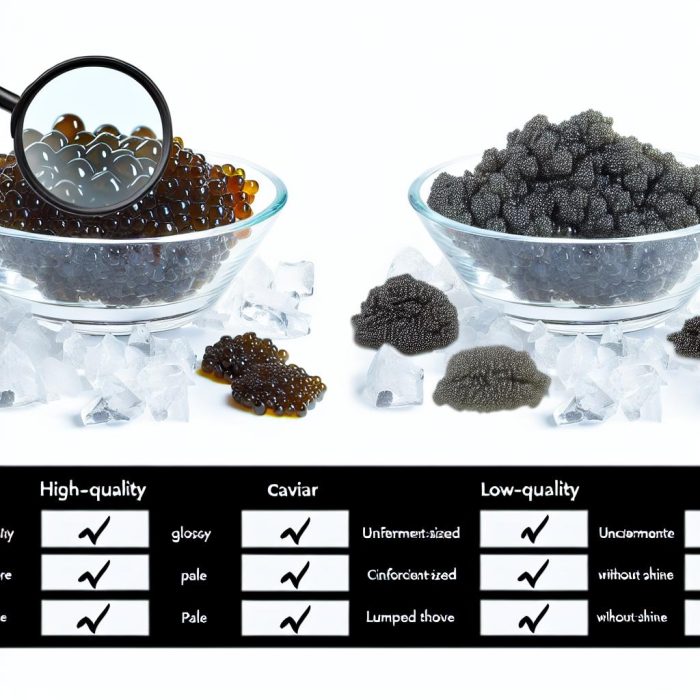Understanding the Basics of Caviar
Caviar, a delicacy comprised of salt-cured fish eggs, has long been a symbol of luxury and sophistication. It is an exquisite food product typically sourced from sturgeon, offering a taste and elegance that appeals to discerning palates. High-quality caviar is both rare and expensive, often accompanied by a sense of exclusivity. Unfortunately, the market is also rife with imitations and low-quality versions that can deceive the unwary. Understanding the nuances that distinguish genuine high-quality caviar from these inferior products is crucial for any enthusiast or gastronome seeking a true gourmet experience.
Distinguishing Factors of Authentic Caviar
The quality of caviar is influenced by several factors, including the type of fish, the method of processing, and the region of origin. These elements collectively determine the product’s distinct flavor, texture, and overall quality.
Caviar sourced from sturgeon species such as Beluga, Osetra, and Sevruga is considered premium and highly sought after. These varieties are renowned for their unique qualities: Beluga caviar is celebrated for its large, delicate pearls and buttery texture; Osetra offers a firm texture with a distinct nutty flavor; and Sevruga is known for its smaller eggs and more pronounced taste. These varieties command high prices due to their distinctive flavors, textures, and rarity, adding to their prestige.
Physical Characteristics
The physical appearance of caviar can offer significant clues to its authenticity and quality. Examining the eggs closely is critical for those seeking to evaluate caviar like a connoisseur. High-quality caviar should exhibit a consistent size, color, and shape. The eggs should be intact and firm, not mushed or broken, which indicates careful handling and processing.
The color of caviar can range from pale green to deep black, largely depending on the sturgeon species. For instance, Beluga caviar is typically light gray to nearly black, while Osetra can range from golden yellow to brown. A uniform appearance in terms of color and sheen suggests that the caviar has been subjected to meticulous selection and has received attentive care during processing.
Aroma and Taste
The aroma and taste of caviar are perhaps the most definitive indicators of its quality. Premium caviar should have a fresh, sea-like aroma without any overly fishy or unpleasant scents. A fresh aroma is critical, as an overpowering fishy scent can suggest spoilage or poor quality.
The flavor profile of high-quality caviar is rich and buttery, often with subtle nutty or briny undertones that enhance its complexity. The burst of brine as the eggs pop is a key characteristic celebrated by enthusiasts. If caviar tastes overly salty or fishy, it may be indicative of inferior quality. A balanced salt content is essential, allowing the natural flavors to shine without being overwhelmed by salinity.
Identifying Low-Quality or Fake Caviar
When approaching the realm of caviar, being able to interpret signs of low-quality or fraudulent products is essential. This involves a combination of keen observation and some technical understanding to ensure that what is being purchased is indeed as advertised.
Substitution Concerns
One common practice is the substitution of more expensive caviar with cheaper alternatives such as roe from paddlefish, salmon, or lumpfish. These substitutes can be passed off as the real product to unsuspecting buyers. The texture and taste, however, often differ significantly, with substitutes lacking the complexity and refinement of true sturgeon caviar.
Authentic caviar will usually bear the name and species of the fish on its label, which should match the expected characteristics of eggs from that species. Therefore, careful examination of packaging labels is advised to validate authenticity and avoid substitute products that do not offer the same culinary value.
Packaging and Labeling
Attention to packaging and labeling can reveal important information about caviar. High-quality caviar typically comes in a vacuum-sealed container with detailed information about the origin, species, and processing date. This level of detail on packaging helps affirm the authenticity of the product.
A lack of such details or labels with vague information may signal fraudulence or attempts to conceal the true nature of the product. Additionally, the physical condition of the packaging is an important indicator of product quality. Containers that are bulging might indicate bacterial activity or improper storage, which can compromise the caviar’s safety and flavor.
Price Considerations
Price can also be an indicator of quality, as genuine high-quality caviar is rarely cheap. The cost reflects not only the product’s rarity and the labor-intensive process of harvesting but also its cultural and gastronomic significance. If a deal seems too good to be true, it likely is. Inexpensive caviar often signals a compromise in quality, either due to species substitution or less rigorous control in processing and storage.
Conclusion
Acquiring high-quality caviar requires scrutiny and awareness. Understanding the key attributes of genuine caviar and common pitfalls associated with imitation products can aid in making informed purchasing decisions. Whether purchasing from a specialty store or an online retailer, equipping oneself with the knowledge to distinguish authentic caviar ensures an enjoyable and genuine tasting experience.
By recognizing the importance of physical characteristics, aroma, taste, packaging, and price, a connoisseur or novice can navigate the complex world of caviar with confidence. As more consumers become informed, the appreciation for this luxurious delicacy continues to grow, enhancing both the respect for traditional harvesting methods and the enjoyment of this refined experience.

